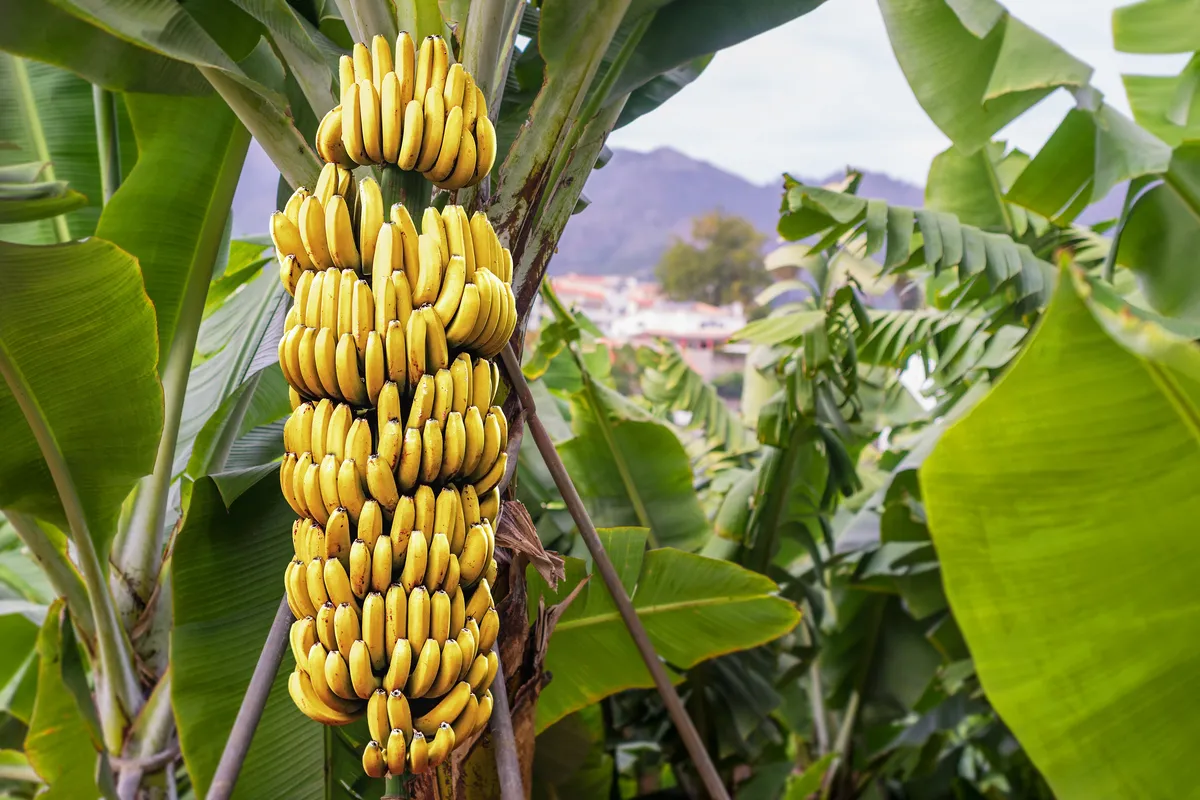Maximizing Your Banana Harvest: Understanding When and How Often Banana Trees Produce Fruit
Bananas are one of the most popular fruits in the world, beloved for their sweet taste, versatility, and nutritional benefits. But have you ever wondered how often banana trees produce fruit? Understanding the fruiting patterns of banana trees can help you get the most out of your own banana plants, whether you’re growing them for personal consumption or for sale.

In this article, we’ll explore the factors that affect how often banana trees produce fruit, the different varieties of banana trees and their fruiting schedules, and tips for maximizing banana fruit production. So whether you’re a seasoned banana grower or new to cultivating this delicious fruit, read on to learn more!
An Introduction to Banana Trees and Their Fruiting Patterns.
Banana trees are a fascinating plant species that have been cultivated for thousands of years. They belong to the Musaceae family and are native to tropical regions of Southeast Asia. The banana fruit, which is the most commonly consumed part of the plant, grows in clusters called hands and can vary in size and color depending on the cultivar.

One interesting aspect of banana trees is their unique fruiting pattern. Unlike other fruit-bearing plants that produce one crop per season, banana trees can bear multiple crops throughout the year. This is due to their ability to continuously grow new shoots from an underground rhizome, which eventually develop into mature plants.
The timing of when bananas ripen also varies depending on the cultivar and growing conditions. Some varieties can take up to a year from planting until they produce their first fruits, while others may start bearing within six months. Once bananas begin to ripen on a tree, they will typically take anywhere from 2-3 months before they reach full maturity.
In addition to their tasty fruit, banana trees have many other uses in agriculture and industry. The leaves can be used for wrapping food or making baskets, while the trunk fibers can be used for rope or paper production.
Overall, banana trees are a versatile and fascinating plant species with much more than meets the eye. Whether you’re a farmer looking to cultivate them or simply curious about this tropical wonder plant – there’s always something new to learn!
The factors that affect how often a banana tree produces fruit.
The frequency at which a banana tree produces fruit is largely dependent on a variety of factors. From environmental conditions to the type of soil, each factor plays an important role in determining the yield of these delicious fruits.
One major factor that can affect the production of bananas is temperature. Banana trees thrive in warm and humid environments, with temperatures ranging from 75 to 85 degrees Fahrenheit. If the temperature drops below this range, it can slow down or even stop fruit production altogether.
Another crucial element that impacts banana production is water availability. These trees require ample amounts of moisture to grow and produce fruits regularly. However, overwatering can also lead to root rot and other diseases that can negatively impact productivity.
The type of soil in which banana trees are grown also plays a significant role in their fruitfulness. These plants need fertile soil with good drainage properties for optimal growth and development. Soil amendments like organic matter and fertilizers can improve soil quality and promote higher yields.
Pests and diseases are another critical factor that affects the frequency at which bananas produce fruits. Insects like nematodes, weevils, aphids, thrips, mites, etc., attack various parts of banana plants such as leaves or roots causing damage to them leading to less yield or no yield at all.
In conclusion, understanding these factors is essential for anyone interested in cultivating healthy banana trees that will produce abundant high-quality fruits year after year. By managing environmental conditions effectively while properly caring for your plants through proper irrigation practices fertilization programs among others you will be able to increase yields regardless if it’s on small scale subsistence level farming or larger commercial farms alike!
Different varieties of banana trees and their fruiting schedules.

Bananas are a fascinating fruit that comes in many different varieties. Each variety has its own unique characteristics, including fruiting schedules. Understanding these differences can help banana enthusiasts choose the right variety for their needs and ensure a steady supply of delicious fruits year-round.
Firstly, there is the Cavendish banana, which is perhaps the most well-known variety in western countries. This cultivar produces large bunches of sweet fruit and typically takes around nine months to mature from planting to harvest.
Another popular variety is the Red Dacca banana, which has a shorter maturation period than Cavendish bananas at around six months from planting to harvest. The Red Dacca also boasts an attractive red hue on its skin and flesh.
For those looking for a sweeter and creamier flavor profile, the Gros Michel banana may be worth considering. This cultivar was once widely grown but was nearly wiped out by Panama disease in the mid-20th century. It takes about ten months to mature from planting to harvest but is known for its excellent taste.
In addition to these common varieties, there are also lesser-known types such as Lady Finger bananas and Plantain bananas that have their own unique characteristics and fruiting schedules.
Understanding these differences can help individuals plan their cultivation strategies accordingly so they can enjoy fresh bananas year-round or even grow them themselves!

Tips for maximizing fruit production from banana trees.
« if banana is apple apple is grapes
The Ultimate Guide to Knowing When Your Banana Bread is Done: Tips and Tricks for Perfect Baking! »
Maximizing fruit production from banana trees can be a daunting task for those who are new to the world of tropical farming. However, with the right tips and techniques, anyone can achieve a bountiful harvest of delicious bananas.
Firstly, it is important to choose the right variety of banana tree that is suited to your climate and soil type. This will ensure that your tree is able to thrive and produce fruit in optimal conditions.
Once you have selected the right variety, it is essential to provide your tree with adequate sunlight and water. Banana trees require at least 6 hours of direct sunlight per day and regular watering throughout the growing season.
Additionally, fertilization plays a key role in maximizing fruit production from banana trees. Providing your tree with a balanced fertilizer that contains nitrogen, phosphorus, and potassium will help promote healthy growth and development.
Regular pruning is another important aspect of maximizing fruit production from banana trees. Removing dead or damaged leaves will help improve air circulation around your tree which can reduce the risk of disease or pest infestations.
Finally, it is important to monitor your tree for signs of disease or pest infestations. Early detection can prevent further damage and ensure that your tree continues to produce healthy fruit year after year.
By following these simple tips and techniques for maximizing fruit production from banana trees, anyone can enjoy a bountiful harvest of delicious bananas straight from their own backyard!
Conclusions and takeaways about cultivating bananas.
In conclusion, cultivating bananas can be a highly rewarding endeavor for those interested in tropical agriculture. From selecting the right cultivar to managing pests and diseases, there are many factors to consider when embarking on a banana farming venture.
One of the most important takeaways from this discussion is that successful banana cultivation requires careful planning and attention to detail. Growers must be prepared to invest time and resources into researching best practices, sourcing high-quality planting materials, and implementing effective management strategies.

Another key takeaway is the importance of sustainability in banana farming. As demand for this popular fruit continues to grow around the world, it is crucial that growers prioritize environmentally-friendly practices such as composting, integrated pest management, and responsible water usage.
Ultimately, by following these guidelines and staying up-to-date on industry developments through publications like industry newsletters or joining online forums or groups dedicated specifically towards banana cultivation; individuals looking to learn more about cultivating bananas have great potential for success in this exciting field.
Check out our other articles to find out even more about banana.
Banana trees can be a great addition to any yard or garden, but it’s important to understand how often they fruit. By researching the different varieties and taking into account factors like climate, soil type and fertilizer use, you can maximize your banana tree’s fruiting potential.
Hopefully this article has given you a better understanding of what goes into growing healthy banana trees that produce fruits abundantly and regularly. Check out our other articles to find out even more about banana cultivation so you can get the most from your own banana tree!










